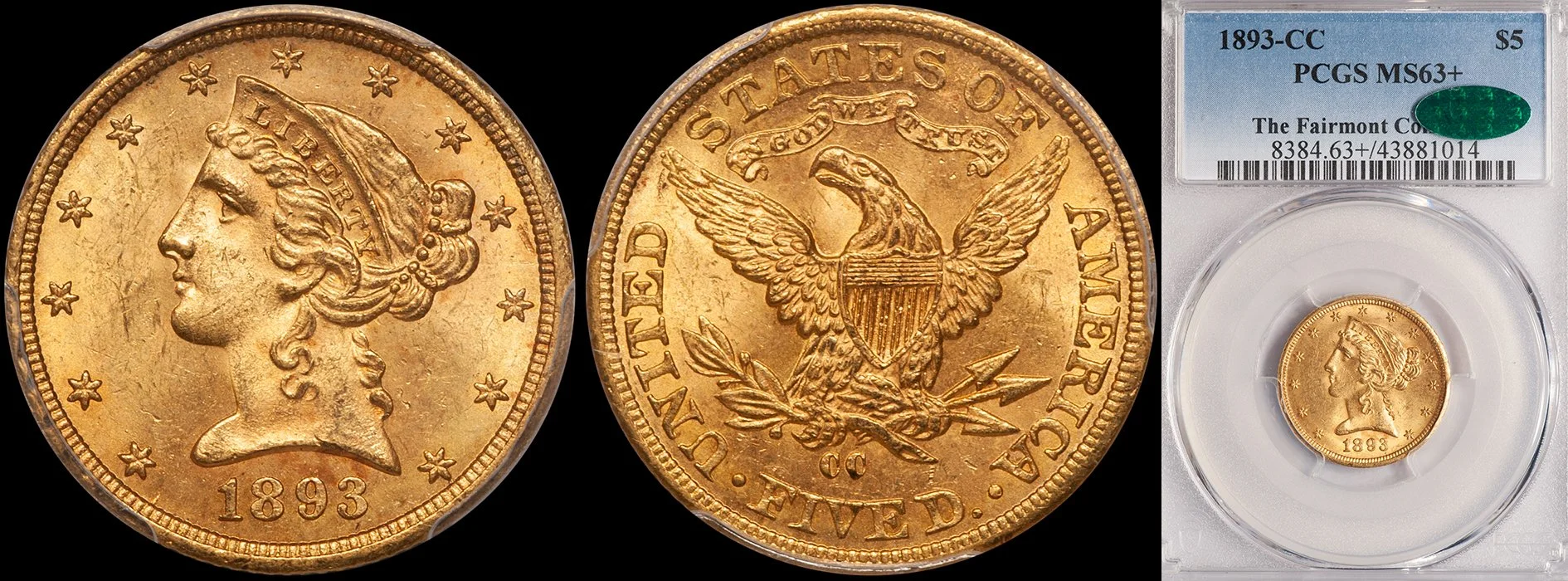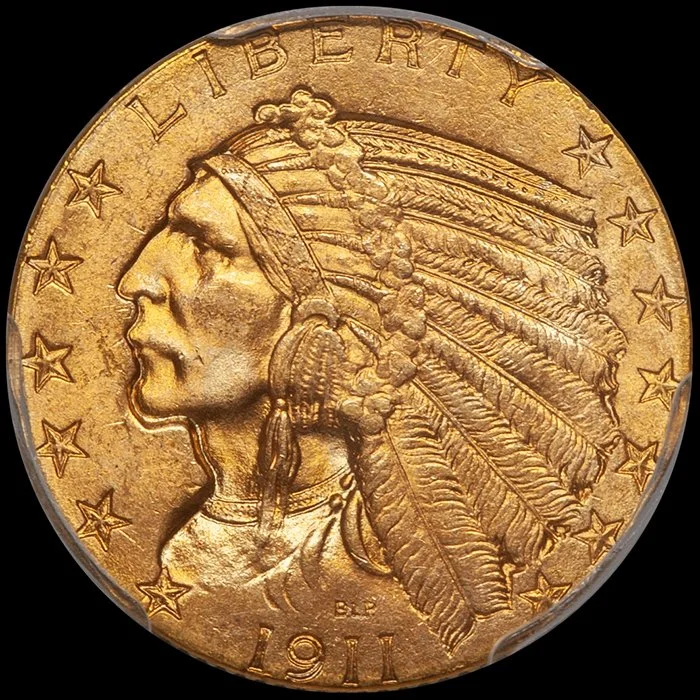Collecting United States Gold Coins by Type
/In the world of rare American gold coins there tends to be two distinct camps: date collectors and type collectors. I have traditionally been a date collector and tend to value scarce/rare issues as opposed to more common issues in higher grades. But I'm beginning to become more interested in the type collecting option and can see how, for a collector without the desire to become a date collector/specialist, collecting by type can be rewarding. Basically, a type collector buys one higher grade example of a specific design or variety as opposed to a date collectors who tries to complete a set of a specific design. There are some interesting ways to collect by type and I thought I would share a few with a particular emphasis on United States gold.
The most basic--and inexpensive--way to collect by type is to assemble a denomination set. This set would include one example of a gold dollar, quarter eagle, three dollar gold piece, half eagle, eagle and double eagle. Many of these denominations contain multiple types, which range from common to very rare. A basic denominational type set would focus on the most common types in a grade range which makes sense to the collector.
In this set, I would choose a Type Three gold dollar (struck from 1856 to 1889), a Liberty Head quarter eagle (struck from 1840 to 1907), a Three Dollar gold piece (struck from 1854 to 1889), a With Motto Liberty Head half eagle (struck from 1866 to 1908), a With Motto Liberty Head eagle (struck from 1866 to 1907) and a St. Gaudens double eagle (struck from 1907 to 1932). With the exception of the Three Dollar, all of these types are reasonably affordable in MS64 to MS65 grades and some are even available in MS66. At the MS64 level, such a set could be completed for around $15,000; certainly within reach of most collectors. In MS65, the cost doubles.
A standard six coin gold type set is a bit boring, though. What are some of the things that can be done to spice up such a set? In many of these types, it is possible to purchase dates which are scarcer for little or no premium. When the market for MS64 and MS65 gold type is strong (which it currently is not) there are dates which can bring a 10%-30% premium. When the market cools off, many of these issues lose their market premium factor and can be bought for little or no premium. They may or may not regain this market premium factor in the future but when they can be bought as common dates, why not?
Or better yet, consider a legitimately scarcer date which makes sense. As an example, in the Type Three gold dollar series, all of the 1879-1889 issues are available in MS65 for around $2,000. For $3,500 or $4,000 you might be able to buy a very scarce gold dollar from the 1868-1878 range in this grade.
How important is it for all the coins in this set to have been graded by one service (NGC or PCGS) and to have CAC verification?
I believe that both NGC and PCGS do a good job grading MS64 and MS65 gold type. One service might be a little tighter than the other on small coins but, for the most part, there is not much value differential between the two when it comes to coins like a 1901-S Liberty Head eagle in MS65.
I would recommend CAC approved coins for most gold types. In the case of certain series like Type Three gold dollars in MS65, the premium is very small but probably worth it. In the case of a popular coin like a St. Gaudens double eagle in MS66, the premium is significant from a percentage basis but from what I've seen, a CAC-approved MS66 Saint tends to be a very high. By the same token, the standard of quality for CAC approved MS66 Saints is very high and these coins are generally far nicer than "standard" MS66 coins.
The standard gold type set consist of twelve coins: the Type One, Type Two and Type Three dollars, the Liberty Head and Indian Head quarter eagle, the Three Dollar, the Liberty Head and Indian Head half eagle, the Liberty Head and Indian Head eagle and the Liberty Head and St. Gaudens double eagle.
In this set, the key issue is the Type Two dollar and, for most collectors, this is usually the lowest grade coin included in a gold type set. As an example, the typical twelve piece type set contains coins in the MS63 to MS65 range (sometimes higher and sometimes lower) but due to cost prohibitions, the Type two tends to be at the lowest end of this range. I have always thought that this was an overvalued type in MS64 and MS65 as these pieces always seem to be available yet are priced in five figures. When gold type set collecting was more popular, Gem Type Two gold dollars traded (infrequently) for $50,000 and up. Today, coins graded MS65 tend to bring closer to $30,000. This is due partially to a diluting of grading standards but mostly due to reduced demand.
The other two coins in this 12 piece type set which are elusive in MS65 are the Three Dollar gold piece and the Indian Head half eagle. The former sells for $12,500-15,000 today, well off its former high of $20,000+. In MS64, the price drops to $7,500 or so, making a nice example within reach of most budgets.
The Indian Head half eagle is probably my single favorite individual type in the 12 coin set from the standpoint of potential appreciation. These have dropped in price in recent years down to $12,000 or so for a non-CAC coin and $15,000 or so for one with CAC approval. Not that many years ago, these coins were selling wholesale for $17,500-20,000. If a large marketing firm were to quietly buy 50 or 75 MS65 Indian Head half eagles and then run up prices, we could easily see levels back where they were a few years ago.
If you are assembling a 12 piece type set of U.S. gold, I think it is worth the premium you will have to pay to acquire high end CAC coins. In many cases, you are looking at paying an extra 25-35% but this appears to be money well spent when it is time to sell the coins.
Should you pay extra money for slightly scarcer dates? In this market, as I mentioned above, you can buy a scarcer coin in many series for little or no premium. I wouldn't suggest paying a small premium for a marginally interesting date. What I would suggest is doing the full 12 piece set with significantly better dates. Instead of choosing an 1878 in MS65 as your Three Dollar gold piece, choose an ultra-low mintage date from the 1880's. Study the population figures for Indian Head half eagles and you will quickly see which dates are far scarcer than the 1908 or 1909-D yet do not command a huge premium.
You can add a few more basic types to make the 12 piece set more complete and more challenging. Five which come to mind are the No Motto half eagle, the No Motto eagle and the Type One and Type Two Liberty Head and High Relief double eagles. These are quite rare and expensive in MS64 to MS65 but can be found in the MS60 to MS63 grades for less than $10,000 in many cases.
What if you have a limited budget and can only spend $2,000-2,500 at most. Is a type set a good option?
I think the collector on a limited budget has some great options. Let's take gold dollars as an example. I would suggest buying a nice MS63 or MS64 Type One which will cost $1,000 to $1,500. For the Type Two, the smartest option might be a "super slider" AU58 which will cost $1,000 or so. For the Type Three, I'd go with an MS64 which will cost $1,000 to $1,250 depending on the date and the quality for the assigned grade.
The thing I like most about collecting by type is that every purchase you make for the set brings a whole new design and a whole new series to explore and research. If you are a true collector, you like to learn about new coins and the thought of studying about a new coin such as a Three Dollar gold piece is, in my opinion, pretty interesting.
It's funny how tastes change among coin collectors. In the 1980's and early 1990's, everyone wanted Gem Type. Today, people prefer rarity. Perhaps a combination of the two--type sets which contain scarce to rare issues--might be the collecting wave of the future.














